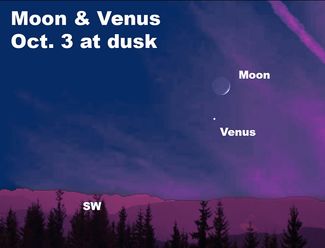Venus and the Moon Return
Last updated 10/3/2016 at 10:16am
If you haven't yet checked out Venus glistening low in the southwestern sky at dusk, now would be a great time to do so. Many people might have missed seeing it there because of low-lying clouds or mountains blocking the view. But with October upon us, it's now beginning to climb higher in our sky, as it rounds the sun.
As more and more people spot its brilliant light in the early-evening sky, more and more misconceptions about just what it is will begin to pop up. I certainly hope that regular readers of this column won't fall prey to them, but you may encounter some in your interactions with less-experienced stargazers.
Perhaps the most common misconception of novice sky watchers is that the brilliant light of Venus is an approaching aircraft with its landing light on. I suppose this is an easy mistake to make; even a World War II fighter pilot reportedly was fooled and actually fired at the planet. He missed.
Another common belief is that Venus is the International Space Station, or ISS. Of course, the ISS orbits the Earth about every 90 minutes, so it appears to drift gracefully across our sky from time to time. Venus doesn't. If you visit the Heavens-Above website, you can predict the passage of the ISS across your sky.
Perhaps most puzzling to me is the idea that Venus is the North Star. I guess folks aren't bothered that it appears in the west!
Whenever you encounter misconceptions such as these, be patient and take time to explain what people are actually seeing. Helping others enjoy the wonders of the night sky is a tremendously rewarding way to spend your time.
Ever since childhood, I've always enjoyed the company of Venus in the glow of twilight, especially when it's nuzzled up against the delicate crescent moon. Fortunately, this sight is not all that uncommon; it occurs once a month or so, as the moon orbits our planet. In fact, such a pairing is coming up this week.
After sunset on Monday, Oct. 3, the delicate crescent moon will appear not far from brilliant Venus and form a magnificent sight in the waning light of dusk.
Be sure to check out the pair with binoculars, since few celestial sights appear more three-dimensional. You'll surely enjoy seeing the faint disk of the full moon -- the result of sunlight being reflected off the Earth back onto the dark side of the moon.
The appearance of this ghostly glow was first explained by the famous 15th-century Italian artist and inventor Leonardo da Vinci. He recognized that when the moon appears as a crescent in our sky, a hypothetical astronomer on the moon would see in his sky a nearly full Earth. And just as a bright moon illuminates the dark night on Earth, a bright Earth would illuminate even more the darkness of the moon. Today, we call this phenomenon "Earthshine."
I hope you'll mark your calendars for Monday's beautiful sky show. I know I'll be out keeping watch at dusk, reliving fond childhood memories.




